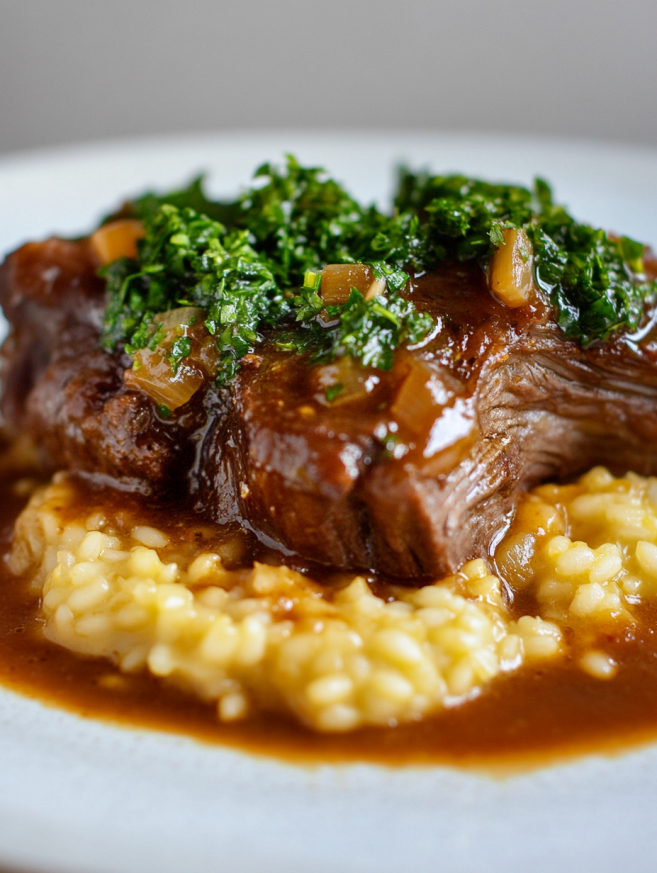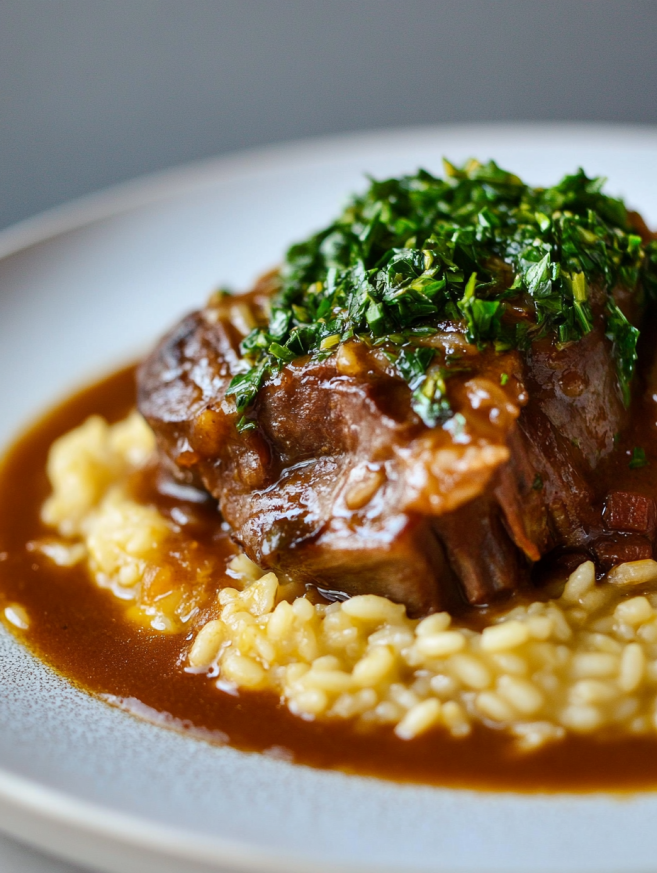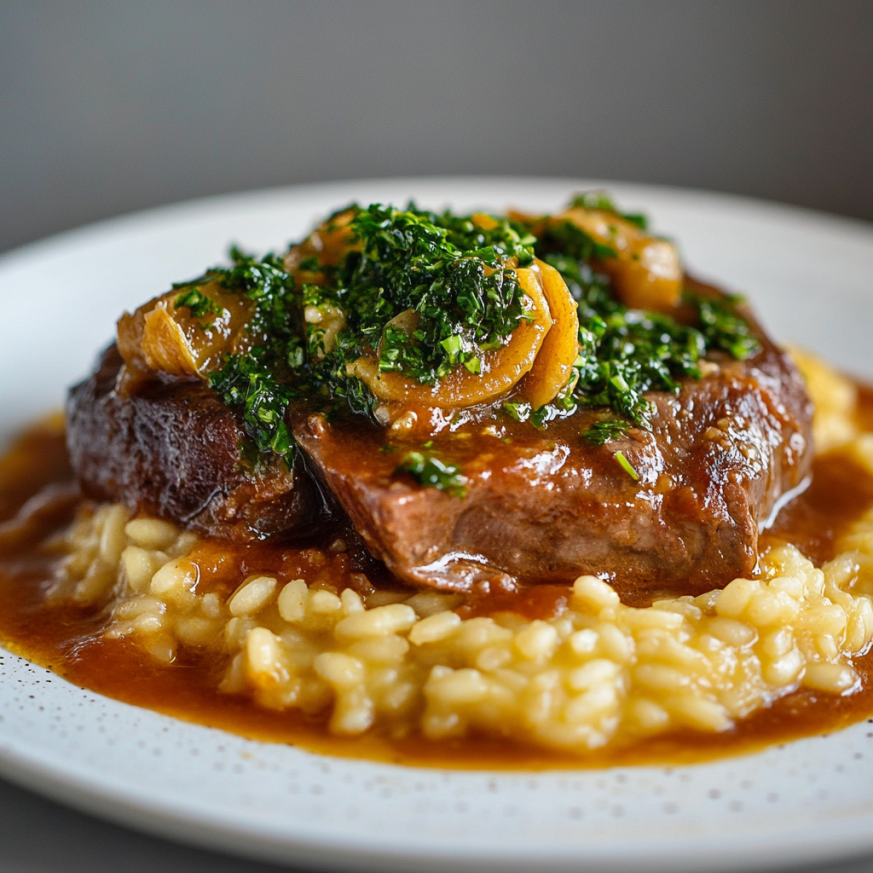There’s something magical about walking into a kitchen where osso buco has been braising for hours. The rich, wine-soaked aroma fills every corner of the house, creating an atmosphere that whispers of Sunday dinners and cherished family traditions. If there’s one dish that feels like a warm embrace from Nonna herself, it’s this classic Osso Buco with gremolata and saffron risotto.
Growing up, I watched my grandmother transform tough veal shanks into silky, fall-off-the-bone perfection through nothing more than patience, good wine, and love. Today, this recipe brings that same magic to my own table, turning any ordinary evening into something truly special.
Prep Time: 10 minutes
Cook Time: 3 hours 30 minutes
Total Time: 3 hours 40 minutes
Serves: 4-6 people
Why You’ll Fall in Love with This Recipe
Restaurant-Quality Results at Home
This isn’t just another braised meat recipe. The combination of properly seared shanks, aromatic vegetables, and a wine-enriched braising liquid creates layers of flavor that rival the finest Italian restaurants. Moreover, the long, slow cooking process ensures the meat becomes incredibly tender while developing a rich, glossy sauce.
The Perfect Trifecta
What makes this dish truly exceptional is how each component complements the others. The creamy saffron risotto provides a luxurious base, while the bright gremolata cuts through the richness with its fresh herbs and citrus notes. Together, they create a harmonious balance that elevates the entire meal.
Impressive Yet Approachable
Despite its elegant presentation, this recipe is surprisingly forgiving. The braising technique is nearly foolproof, and most of the cooking happens hands-off in the oven. Additionally, many components can be prepared ahead of time, making it perfect for entertaining.
Essential Ingredients
For the Osso Buco
- 5 veal or beef osso buco shanks (300g/10oz each) – the star of the show
- 1 cup all-purpose flour – for dredging and developing flavor
- 2 carrots, roughly chopped – adds natural sweetness
- 2 celery stalks, roughly chopped – provides aromatic depth
- 2 brown onions, sliced – builds the flavor foundation
- 1 whole garlic bulb, top sliced off – for mellow, roasted flavor
- 2 tablespoons extra virgin olive oil – for searing
- 4 oz tomato paste – intensifies the sauce
- 1 cup red wine – preferably something you’d drink
- 4 cups beef stock – homemade preferred, but quality store-bought works
- 4 bay leaves and 3 thyme sprigs – classic herb combination
- 3 tablespoons butter – for finishing the sauce
- Salt and pepper – for seasoning throughout
For the Vibrant Gremolata
- 1 cup fresh parsley leaves, finely chopped – the herb base
- 1 tablespoon fresh lemon zest – bright citrus notes
- ¼ cup fresh lemon juice – balances the richness
- 1 garlic clove, minced or grated – adds bite
- 1 cup extra virgin olive oil – creates the sauce consistency
- Salt and pepper – to taste
For the Saffron Risotto
- 2 tablespoons extra virgin olive oil – for sautéing
- 1 brown onion, finely diced – aromatic base
- 2 garlic cloves, finely diced – flavor enhancement
- 1 cup Arborio rice – essential for creamy texture
- 1 cup white wine – adds acidity and depth
- 6 cups warm chicken stock – keep it warm for best results
- 1 teaspoon saffron threads – the golden luxury spice
- 3 tablespoons butter – for creaminess
- ½ cup grated Parmesan cheese – finishing touch
- Salt and pepper – for seasoning
Step-by-Step Instructions
Preparing the Osso Buco
Getting Started Begin by preheating your oven to 320°F (160°C). This moderate temperature ensures gentle, even cooking that won’t dry out the meat. Meanwhile, tightly tie butcher’s string around each shank to help maintain their shape during the long braising process.
Seasoning and Dredging Generously season both sides of the shanks with salt and pepper. Don’t be shy here – the seasoning needs to penetrate the thick meat. Next, spread the flour on a large baking tray and coat each shank thoroughly, tapping off any excess. This flour coating will help create a beautiful crust and later thicken the braising liquid.
Achieving the Perfect Sear Heat olive oil in a large, heavy-bottomed, oven-safe pot over medium-high heat. Once the oil shimmers, carefully place the shanks in the pot without overcrowding. Sear each side for 2-3 minutes until deeply golden and caramelized. This step is crucial – it develops the Maillard reaction that adds incredible depth to the final dish. Remove the shanks and set aside.
Building the Flavor Base
Cooking the Aromatics Reduce the heat to low-medium and add the carrots, celery, onions, and halved garlic bulb to the same pot. Cook for 8-10 minutes, stirring occasionally, until the vegetables soften and become fragrant. The residual fond from searing the meat will coat the vegetables, adding extra flavor.
Intensifying with Tomato Paste Increase the heat to high and add the tomato paste. Cook for 2 minutes, stirring constantly, until the paste turns deep red and begins to stick slightly to the bottom of the pan. This concentrates the tomato flavor and adds richness to the sauce.
Deglazing and Braising Pour in the red wine and scrape up any browned bits from the bottom of the pot. Let the wine cook for 2 minutes until most of it has been absorbed by the vegetables. Return the meat to the pot and add enough beef stock to cover the shanks. Tuck in the bay leaves and thyme sprigs, then season with salt and pepper.
The Long, Slow Braise
Cover the pot tightly and transfer to the preheated oven. Braise for 2.5 to 3 hours, or until the meat is fork-tender and practically falling off the bone. The exact timing depends on the thickness of your shanks, so check occasionally during the last hour.
Finishing the Sauce
Straining for Elegance Carefully remove the osso buco and roasted garlic from the pot – they’ll be incredibly tender, so handle gently. Strain the braising liquid through a fine-mesh strainer into a bowl, then transfer it to a large frying pan.
Creating Silky Perfection Bring the strained sauce to a gentle simmer over medium heat. Squeeze the soft, roasted garlic cloves directly into the sauce and whisk until incorporated. Add the butter and continue cooking for 5 minutes until the sauce thickens slightly and develops a glossy sheen.
Final Assembly Return the osso buco to the sauce and baste repeatedly for several minutes, allowing the meat to absorb those concentrated flavors.

Mastering the Saffron Risotto
Building the Base
While the osso buco finishes, start your risotto. Heat olive oil in a large frying pan over medium heat. Add the diced onion and garlic, cooking for 2 minutes until softened and aromatic. The key here is gentle cooking – you want to coax out the sweetness without browning.
Toasting the Rice
Add the Arborio rice to the pan and stir constantly for 2 minutes until the grains turn opaque and slightly translucent around the edges. This toasting step is essential for preventing mushy risotto. Pour in the white wine and stir continuously until it’s completely absorbed.
The Gradual Stock Addition
Here’s where patience pays off. Reduce the heat to medium-low and add the warm chicken stock one cup at a time, stirring constantly. Each addition should be almost completely absorbed before adding the next. This process takes about 25 minutes, but the result is worth every minute of stirring.
The Golden Finish
After adding the final cup of stock (when it’s 80% absorbed), stir in the saffron threads. Watch as the rice transforms into a beautiful golden color. Remove from heat and vigorously stir in the butter and Parmesan cheese until creamy and glossy. Season with salt and pepper to taste.
Creating the Perfect Gremolata
This bright, herbaceous sauce is surprisingly simple but absolutely essential. In a bowl, combine the finely chopped parsley, lemon zest, lemon juice, minced garlic, and olive oil. Stir until well combined and season with a pinch of salt and pepper. The gremolata should be made just before serving to maintain its vibrant color and fresh flavor.
Serving Suggestions
The Classic Presentation
Serve the osso buco on a bed of warm saffron risotto, spooning the rich braising sauce generously over the meat. Top with a generous dollop of gremolata, allowing its bright green color to contrast beautifully with the golden risotto.
Wine Pairing Perfection
A full-bodied red wine complements this dish beautifully. Consider a Barolo, Chianti Classico, or even the same wine you used for braising. For white wine lovers, a rich Chardonnay can work surprisingly well with the creamy risotto.
Elegant Accompaniments
While this dish is substantial on its own, a simple arugula salad dressed with lemon vinaigrette provides a nice acidic contrast. Alternatively, roasted asparagus or broccolini adds color and freshness to the plate.
Creative Recipe Variations
Lighter Alternatives
For a lighter version, substitute chicken thighs for the veal shanks and reduce the cooking time to 1.5 hours. The result is equally delicious but more weeknight-friendly.
Herb Variations
Experiment with different herbs in your gremolata. Fresh mint, basil, or even cilantro can create interesting flavor profiles while maintaining the sauce’s bright, fresh character.
Risotto Alternatives
If saffron is unavailable or too expensive, try mushroom risotto or even a simple herb risotto. Polenta is another traditional accompaniment that pairs beautifully with the rich braising liquid.
Make-Ahead Magic
Planning for Success
This dish actually improves with time, making it perfect for entertaining. The osso buco can be braised up to two days in advance – simply reheat gently in the sauce before serving.
Storage Solutions
Store the cooled osso buco in its braising liquid in the refrigerator for up to three days. The sauce will solidify when cold due to the natural gelatin from the bones, which is actually a sign of a well-made dish.
Reheating Tips
When ready to serve, reheat the osso buco gently in a covered pot over low heat. Add a splash of stock if the sauce seems too thick. The risotto is best made fresh, but the gremolata can be prepared several hours ahead.
Professional Tips and Notes
Ensuring Perfect Results
Tying the shanks with kitchen twine isn’t just for presentation – it prevents the meat from curling and helps maintain an even shape during the long braise. If you don’t have twine, make shallow cuts through the connective tissue around the edges.
Meat Selection Wisdom
While veal shanks are traditional, they’re not always available. Beef shin or beef osso buco cuts are excellent substitutes that still deliver that melt-in-your-mouth texture. Look for cuts that are about 2 inches thick for the best results.
Sauce Refinement
For an ultra-smooth, restaurant-style sauce, strain the braising liquid and reduce it separately. This extra step creates a more refined presentation, though it’s not necessary for home cooking.
Temperature Control
Use a meat thermometer if you’re unsure about doneness. The internal temperature should reach 160°F (71°C), but more importantly, the meat should easily pull apart with a fork.

Frequently Asked Questions
Can I make this without wine? While wine adds incredible depth, you can substitute with additional beef stock and a tablespoon of balsamic vinegar for acidity. However, the flavor will be noticeably different from the traditional version.
Why is my risotto gummy? Gummy risotto usually results from adding cold stock or stirring too vigorously. Always use warm stock and stir gently but consistently. Additionally, don’t skip the rice-toasting step.
How do I know when the osso buco is done? The meat should be so tender it almost falls apart when you try to lift it. If you can easily twist a fork in the meat and it shreds, it’s ready.
Can I freeze leftovers? Yes, the braised osso buco freezes well for up to three months. However, risotto doesn’t freeze successfully, so it’s best made fresh each time.
What if I can’t find saffron? Saffron is expensive but worth it for special occasions. In a pinch, you can substitute with a small amount of turmeric for color, though the flavor will be different.
How thick should the gremolata be? The gremolata should have the consistency of a loose paste or thick sauce. If it seems too thick, add more olive oil; if too thin, add more herbs.
Nutritional Information (per serving):
Calories: 1237 | Carbohydrates: 82g | Protein: 23g | Fat: 84g | Fiber: 5g
Note: Nutritional information is automatically calculated and should be used as an approximation only.

